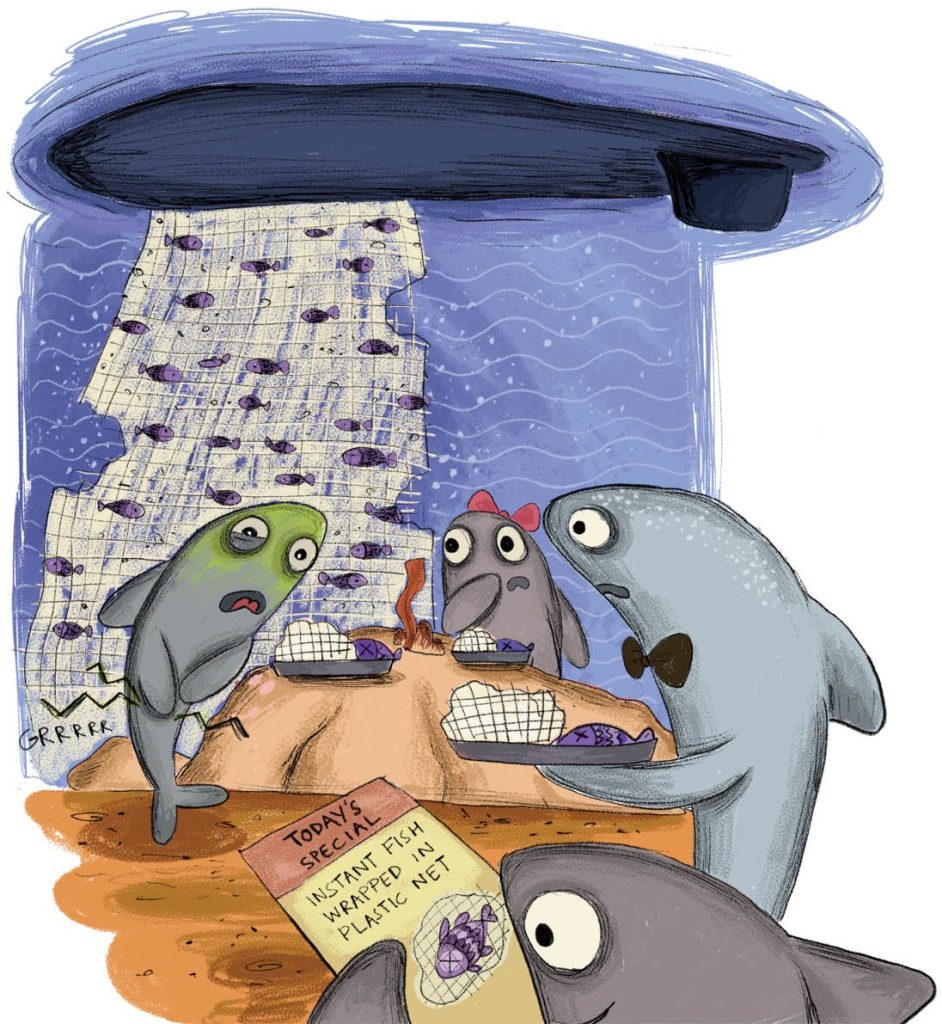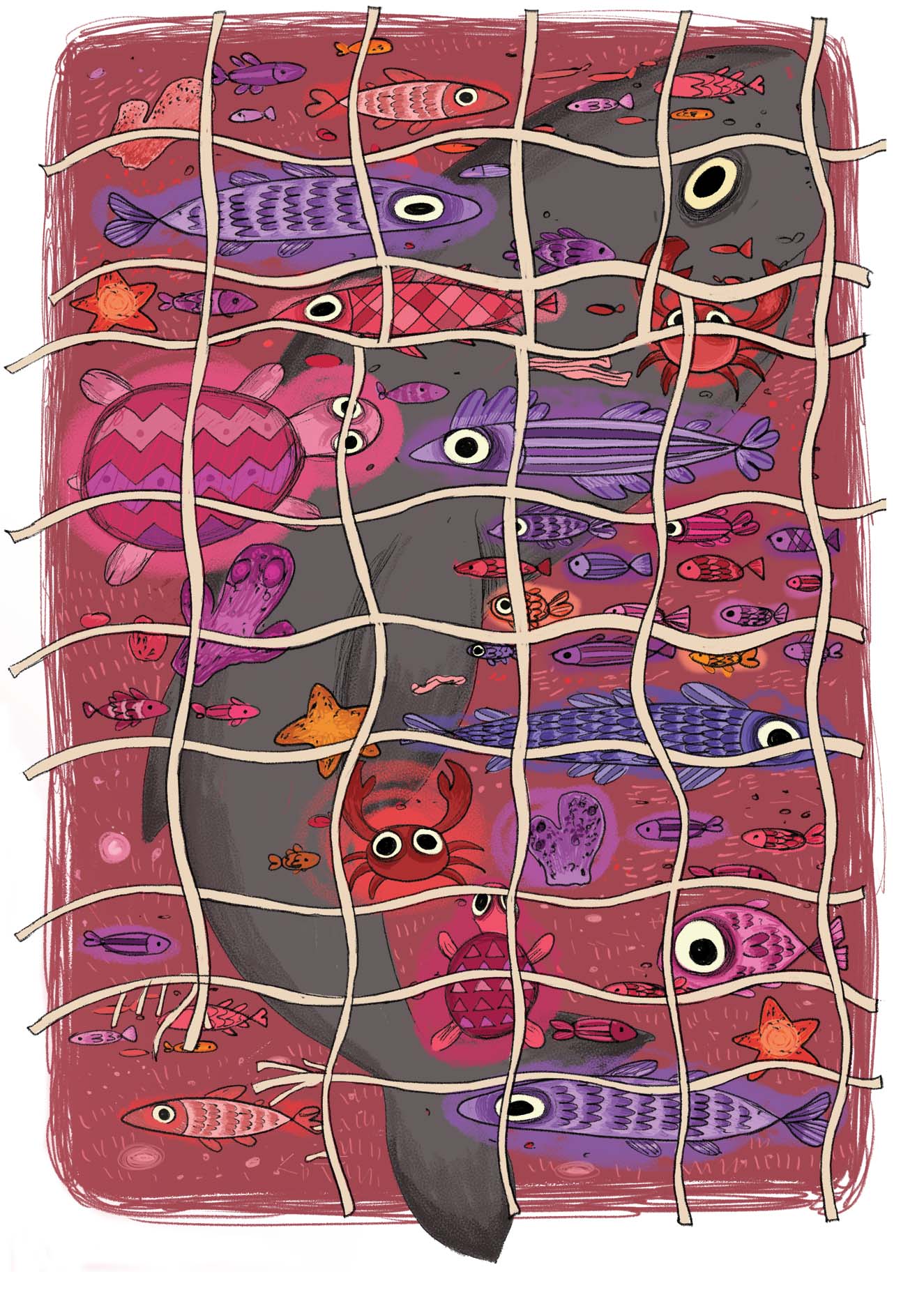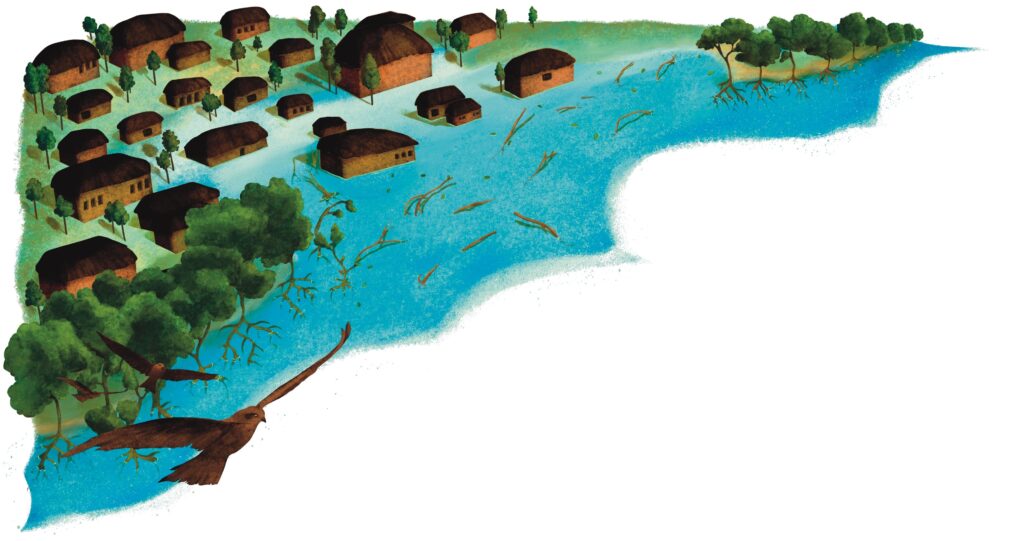Many of us relish the taste of fish in our cuisines. Some of us speculate where the fish must have come from, but only a handful of us wonder how it was caught at sea. Indeed, human ingenuity, fuelled by our love for seafood, has led to a myriad of ways of catching fish. Crafts can vary depending on the type, shape and size of fish that needs to be caught, and each one of them can be used slightly differently depending on the area, the fisher’s knowledge, and the fish that is prized most.
The words ‘fishing net’ conjure the image of an intricately woven rectangle, similar to pigeon nets in our balconies. Such nets are called gillnets because fish are caught by their gills as they try to travel through the spaces in the net. When you encircle a gillnet around a fish shoal and seal it from the bottom before hauling, it is a purse seine net (resembling a coin pouch more than a purse). And then there is a trawl net—a cone made of fine-sized net dragged underwater by a boat, scooping out fish and all other creatures in its path. Depending on where, when and how much they are used, all fishing gears impact marine ecosystems differently. And some clever animals such as dolphins have learnt to use them to their own advantage.
So, what’s the catch?
No fishing gear is perfect. While we intend to fish for particular species, we often end up catching a lot more that may not be of direct use to us. These byproducts of fishing are referred to as ‘bycatch’ and can include everything from tiny sea stars and corals to colossal whales and turtles. Globally, more than a third of all that we catch may be bycatch and that is inarguably a problem, more so for species that live long and reproduce slowly—like dolphins. So why don’t dolphins avoid these treacherous nets and live happily ever after?
As endless as it may seem, the ocean is a finite resource. It is a desert with few ephemeral ‘hotspots’ of fish aggregations. Therefore, fish—the beloved food of all dolphins—is an extremely prized resource and dolphin pods may travel hundreds of kilometres in search of them. Naturally then, our fishing gears that artificially concentrate fish in small areas before pulling them up to the boat are like an ‘all you can eat’ buffet, albeit a risky one where entanglement in the fine plastic lines of the gear can be dangerous.
Dolphins, like us, are air-breathing mammals that need to surface regularly to breathe. Getting caught in a heavy net makes it difficult—sometimes impossible—to resurface and so dolphins can die of asphyxiation. Interacting with fishing gear is therefore a ‘high risk, high reward’ game which needs to be played with utmost caution, and understanding how dolphins make these decisions is of much interest to many like myself. But first, how do dolphins even know where the fishing boats are in the vast open ocean?
For whom the dining bell tolls
Close to the Hawaiian Islands, false killer whales have been documented approaching longline fishing vessels as they haul their catch from the sea. It appears that the mechanical sounds of gears grinding as the net is pulled from the sea acts a ‘bell’ or cue for the animals to approach the ship for food. Similarly, bottlenose dolphins in Australia have learnt to travel inside the conical structure of trawl nets to feed and then escape swiftly. But do all dolphins engage with fishing gears in the same way? Are some individuals more risk-taking than others, or are there some that have perfected the art of fish-taking? Do mothers—who usually occur in groups or pods—engage less frequently in such activities to protect their young? My research in Goa, on the western coast of India, is trying to answer some of these questions.
Characterised by a conspicuous hump seating the dorsal fin on their grey/white body, humpback dolphins are commonly found along the coasts of India. They occur very close to the shore (less than two kilometres away) and therefore greatly overlap with the diversity of fishing gear in the country. In Palk Bay, Tamil Nadu, fishers state that humpback dolphins appear near their boats as soon as they dip their gillnets into the waters every morning. In fact, stories of these dolphins tearing fishing nets to feed on fish are common from across the country, which is concerning because plastic nets cannot be digested and are also a huge loss for the fishers. If nets accumulate in a dolphin’s stomach the animal may not be able to feed on anything and die of starvation. Humpback dolphins occur in relatively high densities in Goa and are often spotted near fishing boats. But do all of them indulge in the high risk/reward game of bycatch?
Understanding dolphin-fisheries interactions in Goa
In Goa, my team and I use drones to follow dolphin pods from a safe distance as they travel along the coast, and we record how dolphins behave around various objects, including fishing nets. This helps us not only answer if dolphins prefer particular nets, but also to understand what kind of animals—for example, large versus small pods, mother-calves versus solitary individuals—engage more frequently with nets, and whether they make more risky decisions in the summer, when there are fewer fish in the sea.
Our initial assessments suggest that dolphins are surprisingly averse to fishing nets. In fact, they may also feed in the same area as fishing boats without interacting with them. Perhaps these skilful hunters do not need to play the human risk/reward game to survive, or perhaps there are only a few individuals who have learned the rules and are willing to take their chances. In the rare cases that dolphins interact with nets, they likely tear and ingest them. Several cases of dolphin deaths, presumably due to interactions with and ingestion of fishing nets, have already been documented in Goa.

Nevertheless, it is exciting to understand why dolphin-fisheries interactions may be rare. Perhaps this is the case worldwide and we haven’t looked closely enough—most studies report dolphins foraging near fishing nets but few record whether they interact with nets, simply because it is difficult to do so without using sophisticated tools such as drones. Perhaps not all animals interact equally. Or perhaps different dolphin populations and individuals are unique in their behaviours, which are defined by their history and knowledge.
Conserving the dolphins of Goa
All dolphins found in India are protected by the Wildlife Protection Act of 1972, but whether or not dolphins choose to interact with fishing nets is not governed by the fishers operating the net. Instead, it is likely a choice guided by several environmental factors, including how much fish is available for the dolphins to eat in the sea.
Decades ago, as old fishers of Palk Bay recall, dolphins fished very close to their boats but rarely took fish from their nets. In the Ashtamudi river mouth of Kerala, cast net fishers use cues from humpback dolphins to understand fish movement patterns and catch more fish. In fact, this synergy between dolphins and fishers has been documented throughout the world, but is corroding away as fish numbers drop, increasing the competition between fishers and dolphins. Perhaps dolphin-fisheries interactions were rare and maybe even beneficial to fishers when there were plenty of fish for all. In the past few decades fish catch has steeply declined throughout India likely due to unregulated large-scale fishing activities fuelled by government agendas to extract as much fish-resources as possible from the ocean. This likely increased the competition for fish between dolphins and fishers leading to severe negative consequences for both.
Still, working in Goa to understand dolphin behaviour has inspired hope. Goa has a strong and vibrant network of researchers, activists, locals and organisations that are dedicated to conserving not only dolphins but the entire coastal ecosystem. Organisations such as Terra Conscious, Reef Watch, Coastal Impact and many more have been working closely with both the government to develop better management strategies for the coasts as well the locals/tourists to explain the workings of a complex system and people’s role in protecting it. Since the coast is a multi-group use area, other stakeholders including the fisheries and the tourism unions, their respective departments, the coast guard, and the navy must also band together to develop and implement large-scale plans to protect dolphins.
The journey of a fish from the sea to one’s plate is a long and complicated one. And dolphin-fisheries interactions are just as complex and nuanced as human-stock market interactions which are shaped by local, historical and individual-level factors. We are still a long way from understanding them, but I do sometimes wonder how likely it is that the fish on my plate is there because a dolphin decided not to take it from a net.
Further reading:
Banerjee, A. 2024. Humpback Dolphins: Sharing Coastal Spaces with Humans in Vembanad. Roundglass Sustain. https://roundglasssustain.com/conservation/humpback-dolphin
Muralidharan, R. 2020. Conservation on a Contested Coast: Indo-Pacific Humpback Dolphins and Fisheries Interactions in Tamil Nadu, India. Rufford Foundation.
https://www.rufford.org/projects/rahul-muralidharan/conservation-on-a-contested-coast-indo-pacific-humpback-dolphins-and-fisheries-interactions-in-tamil-nadu-india/
Cantor, M., D. R. Farine and F. G. Duara-Jorge. 2023. Foraging synchrony drives resilience in human–dolphin mutualism. PNAS 120(6): e2207739120.
doi.org/10.1073/pnas.2207739120.






